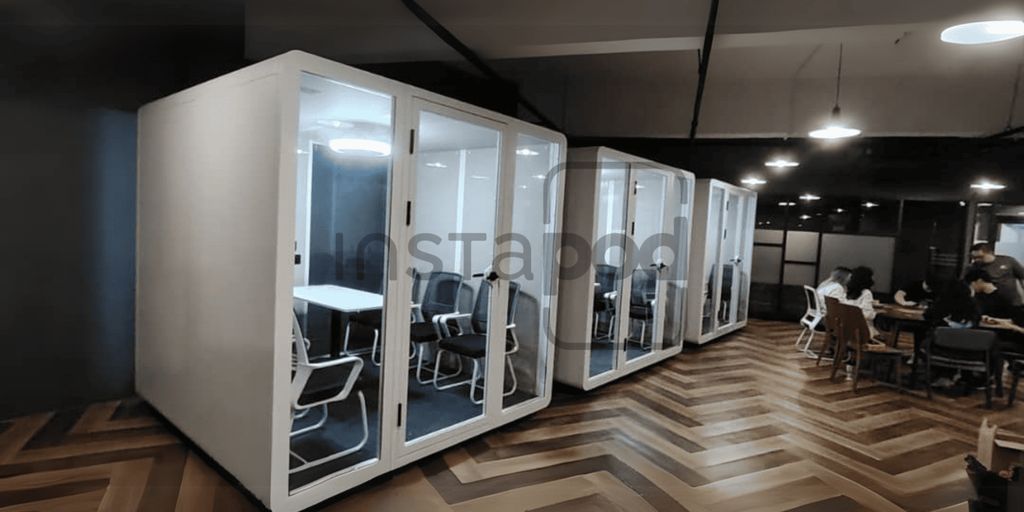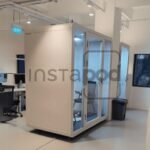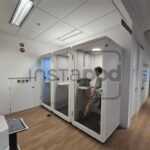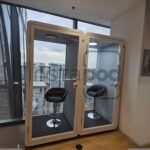No pods added to your quote request yet. Add some now for a free quote!
In today’s fast-paced world, finding a quiet spot to focus can be tough, especially in busy offices or shared homes. That’s where acoustic office pods come in. These cool, self-contained spaces are designed to block out noise and give you a peaceful place to work. They’re becoming super popular because they offer a simple way to get privacy and concentrate without needing big, messy renovations. This guide will walk you through everything you need to know about picking the right acoustic office pods for your space, from what they are to how to set them up for the best results.
Key Takeaways
- Acoustic office pods offer a quiet, private space for focused work, unlike regular cubicles.
- Good design in a pod means it helps you stay on task, with features like solid soundproofing and comfortable interiors.
- When picking pods, think about what your team really needs and how many people will use them.
- Pods can fit into many places, from small home offices to big corporate spaces, and even outside.
- For a pod to work well, consider durable materials, good airflow, and easy power access during setup.
What Is An Acoustic Office Pod?
Defining the Modern Workspace Sanctuary
So, what exactly is an acoustic office pod? Well, think of it as your personal escape from the chaos of the modern office. It’s a freestanding, self-contained unit designed to provide a quiet and private workspace. Unlike traditional cubicles, these pods are engineered with sound dampening materials to minimize distractions. You might see them called privacy booths or even office phone booth, but the idea is the same: a dedicated space for focused work or confidential conversations.
Beyond the Cubicle: Why Acoustic Office Pods Matter
Why are these things becoming so popular? Because the open office concept, while great for collaboration, often falls short when it comes to concentration. Acoustic privacy pods offer a solution by providing a dedicated quiet zone. They’re not just about blocking out noise; they’re about creating an environment where you can truly focus. Here’s why they matter:
- Increased Productivity: Fewer distractions mean better focus and higher output.
- Enhanced Privacy: Ideal for sensitive calls or tasks requiring confidentiality.
- Improved Employee Well-being: Reduces stress and promotes a more comfortable work environment.
Acoustic office pods are more than just a trendy office addition; they’re a strategic investment in employee productivity and well-being. They address the shortcomings of open-plan offices by providing a dedicated space for focused work and private conversations.
Transforming Open Spaces with Acoustic Office Pods
Acoustic office pods are changing the way we think about office layouts. They offer a flexible and adaptable solution for creating private workspaces within existing open environments. Instead of costly and disruptive renovations, companies can simply install these pods to provide employees with the quiet they need. They come in various sizes and designs, from single-person pods to larger meeting pods, making them suitable for a wide range of needs. The ability to easily relocate or reconfigure these pods also adds to their appeal, allowing businesses to adapt their workspaces as their needs evolve. They are a practical solution for any modern office.
Design Elements That Fuel Productivity
Let’s face it, a fancy-looking acoustic office pod is useless if it doesn’t actually help you get work done. It’s not just about sticking a pod in the office; it’s about making sure the design actively boosts productivity. We’re talking about creating a space where people want to be, a place that helps them focus and feel good while they’re at it.
Soundproofing That Works
Obviously, soundproofing is the main thing. But it’s not just about blocking out noise; it’s about creating a comfortable acoustic environment. Effective soundproofing minimizes distractions, allowing for better concentration and reduced stress. Think about it: constant background chatter, keyboard clicks, and phone calls can really wear you down over time.
Here are some things to consider:
- Material Density: Denser materials block sound more effectively. Look for pods with thick walls made of materials like mass-loaded vinyl or multiple layers of acoustic panels.
- Sealed Construction: Gaps and cracks let sound leak through. Make sure the pod has tight seals around doors and windows.
- Acoustic Absorption: Sound-absorbing materials inside the pod prevent echoes and reverberation, creating a clearer, more comfortable sound environment.
Optimizing Interior Comfort and Functionality
Comfort is key. If the pod is uncomfortable, no one will want to use it, no matter how soundproof it is. Think about ergonomics, lighting, and ventilation. An ergonomic chair is a must.
- Ergonomic Furniture: Adjustable chairs, desks, and monitor arms can help prevent strain and fatigue.
- Natural Light (or Good Artificial Light): Natural light is ideal, but if that’s not possible, make sure the pod has good-quality artificial lighting that reduces glare and eye strain.
- Ventilation: Proper ventilation is essential for maintaining air quality and preventing stuffiness. Nobody wants to work in a box that smells like old coffee.
A well-designed interior promotes well-being and reduces physical discomfort, leading to increased focus and sustained productivity. It’s about creating a space that supports the user’s needs, both physically and mentally.
Integrated Technology for Seamless Workflow
In today’s world, technology is essential for most jobs. The pod needs to seamlessly integrate with the technology people use every day. This means having enough power outlets, good cable management, and maybe even built-in monitors. Consider adding monitor arms to free up desk space.
- Ample Power Outlets: Make sure there are enough outlets to power laptops, phones, and other devices.
- Cable Management: Keep cables organized and out of the way to prevent clutter and tripping hazards.
- Connectivity: Consider adding features like USB ports and wireless charging pads for added convenience.
Choosing The Right Number And Types Of Acoustic Office Pods
Assessing Your Team’s Diverse Needs
Figuring out what your team actually needs is the first step. It’s easy to assume everyone wants the same thing, but that’s rarely true. Some people might need quiet spaces for focused work, while others need areas for collaboration and quick chats. Think about the different types of work happening in your office. Are there a lot of phone calls? Do people need to brainstorm together? Are there tasks that require intense concentration? Understanding these different needs will help you decide what kinds of acoustic office pods to get.
- Consider conducting a survey to gather feedback from your team.
- Observe how people are currently using the space.
- Talk to team leaders about their specific requirements.
Balancing Quantity and Space Efficiency
Okay, so you know what you need. Now, how many pods can you realistically fit? You don’t want to cram so many pods into the office that it feels claustrophobic. It’s a balancing act. You need enough pods so people aren’t fighting over them, but not so many that they take over the entire workspace. Think about the size of the pods and how much floor space they’ll occupy. Also, consider the flow of traffic in the office. You don’t want pods blocking walkways or creating bottlenecks.
| Pod Type | Typical Capacity | Footprint (Approx.) |
|---|---|---|
| Phone Booth | 1 person | 4ft x 4ft |
| Focus Pod | 1 person | 5ft x 5ft |
| Small Meeting Pod | 2-4 people | 8ft x 6ft |
| Large Meeting Pod | 4-6 people | 10ft x 8ft |
Strategic Placement for Maximum Impact
Where you put the pods matters just as much as how many you get. Don’t just stick them in a corner and call it a day. Think about where people naturally congregate and where noise levels are highest. Placing pods near these areas can help reduce distractions and provide a quiet escape. Also, consider the proximity to other amenities, like printers or coffee machines. You want the pods to be accessible but not in the middle of everything. For meeting room pods, think about visibility and access to presentation equipment.
Think about the overall layout of your office. Are there areas that are naturally quieter than others? Can you create zones for different types of work? Strategic placement of acoustic office pods can help reinforce these zones and create a more productive and comfortable work environment.
Smart Setups For Every Space
It’s amazing how much difference the right setup can make. Whether you’re squeezing a workspace into a tiny apartment or trying to create quiet zones in a bustling office, there’s an acoustic pod solution. Let’s look at some ideas tailored for different environments.
Acoustic Office Pods for Small Home Offices
For small home offices, space is at a premium. The key is to maximize functionality without making the area feel cramped. Think about a pod that’s pre-wired for power and lighting to save you the hassle of electrical work.
Consider these elements:
- A compact sit-stand desk to keep you energized.
- An ergonomic chair with good lumbar support.
- Vertical storage solutions to keep your desk clear.
Natural light is your friend. Position the pod near a window if possible. A simple desk and folding chair inside will keep things flexible. If you have a bit more room, a rolling cart for supplies can be a lifesaver.
Integrating Acoustic Office Pods in Corporate and Open Offices
Open offices can be noisy and distracting. Acoustic pods offer a refuge for focused work or private conversations. When integrating pods into a corporate setting, think about the needs of different teams and individuals.
Here’s a table showing pod types and their ideal uses:
| Pod Type | Ideal Use |
|---|---|
| Phone Booth Pod | Quick calls, private conversations |
| Small Meeting Pod | Small team meetings (2-4 people) |
| Focus Pod | Individual focused work, video conferencing |
Consider these points when planning:
- Place pods strategically to minimize disruption to the main workspace.
- Ensure adequate ventilation and airflow within the pods.
- Provide easy access to power and data connections.
Outdoor Acoustic Office Pods for Unique Environments
Working outdoors can be a refreshing change of pace, but it also presents unique challenges. Outdoor acoustic pods need to be durable, weather-resistant, and comfortable.
Look for these features:
- Insulation to protect against heat and cold.
- A secure anchoring system for uneven ground.
- Enough space for both work and relaxation.
Consider a dual-zone layout with a workstation on one side and a lounge area on the other. This setup is great for creating a multipurpose space in your backyard.
Build Considerations From The Job Site
So, you’ve picked out your perfect pod. Awesome! Now comes the part where we make sure it’s not just a pretty box, but a solid, long-lasting addition to your space. This is where some practical know-how comes in handy.
Selecting Durable Materials for Longevity
Choosing the right materials is key to ensuring your acoustic office pod stands the test of time. Think about it – you don’t want to be replacing parts or dealing with rot in a few years. For the frame, consider steel or treated wood. For the exterior, look at options like composite siding or durable metal panels. Inside, opt for materials that are easy to clean and maintain, like laminate or vinyl. These choices will impact the acoustic office pod pricing, but it’s worth it in the long run.
Ensuring Proper Ventilation and Airflow
No one wants to work in a stuffy box! Ventilation is super important. Make sure your pod has a good system for bringing in fresh air and getting rid of stale air. This could be as simple as operable windows or as complex as a dedicated ventilation system. Consider adding a small fan or air purifier to help circulate the air and keep things fresh. Proper airflow also helps prevent moisture buildup, which can lead to mold and other problems. Here are some options to consider:
- Install an exhaust fan.
- Use air-permeable materials for interior finishes.
- Ensure adequate gap around the door for natural airflow.
Planning Electrical Routing and Power Access
Think about where you’ll need outlets and how you’ll run the wires. It’s much easier to plan this out before you start building than to try and add it later. Consider things like lighting, computers, and other devices you’ll be using inside the pod. Make sure you have enough outlets and that they’re in convenient locations. Also, think about how you’ll connect the pod to your main power source. Will you need to run a new circuit? Do you need a permit for that? These are all important questions to answer before you start. If you’re not comfortable working with electricity, it’s always best to hire a qualified electrician. This is especially important for acoustic office pods that are outdoors.
Don’t skimp on the electrical work. A poorly wired pod can be a fire hazard. Always follow local codes and regulations, and if you’re not sure about something, ask a professional. It’s better to be safe than sorry.
Understanding Acoustic Office Pod Costs
Factors Influencing Acoustic Office Pod Pricing
The price of an acoustic office pod can vary quite a bit, depending on several things. Size is a big one; a pod for one person will naturally cost less than a meeting pod designed for four. Materials also play a role. Cheaper materials will bring the initial cost down, but might not last as long or provide the same level of soundproofing. Features like integrated lighting, ventilation, and power outlets will also increase the price. Finally, the brand and where you buy it from can affect the cost. Some brands are known for high-end products and charge a premium.
Cost-Benefit Analysis of Acoustic Office Pods
Okay, so you’re looking at the price tag and wondering if it’s really worth it. Let’s break it down. Think about how much time your employees waste getting distracted by noise. How much does it cost you when they have to leave the office to find a quiet place to focus? Acoustic pods can reduce these costs by providing a dedicated quiet space. Plus, they can be cheaper than building permanent offices or renovating existing spaces. Here’s a simple table to illustrate:
| Benefit | Estimated Value (per employee/year) | Notes |
|---|---|---|
| Reduced Distractions | $500 – $2000 | Based on increased productivity and fewer errors. |
| Avoided Renovation Costs | $1000 – $5000 | Compared to building a new office. |
| Increased Employee Morale | $200 – $500 | Happier employees are more productive and less likely to leave. |
Investing in acoustic office pods isn’t just about the initial cost; it’s about the long-term benefits they bring to your team and your bottom line. Consider the value of increased focus, reduced distractions, and improved employee well-being.
Long-Term Value of Investing in Acoustic Office Pods
So, you’ve bought the pod. What happens next? Well, a good quality pod should last for years, providing a consistent quiet space for your employees. Because they are modular, you can move them around if you rearrange your office. This flexibility can save you money in the long run, as you won’t need to build new offices every time your needs change. Plus, happy, productive employees are more likely to stick around, reducing turnover costs. Here are some things to consider:
- Durability of materials used.
- Flexibility and ease of relocation.
- Impact on employee retention rates.
Sizing Your Acoustic Office Pod
Matching Pod Size to User Needs
Okay, so you’re thinking about getting an acoustic office pod. Great! But before you click ‘buy,’ you need to figure out what size pod actually makes sense for you. It’s not just about fitting the pod into your space; it’s about fitting your life into the pod. Are you a lone wolf who just needs a quiet place to focus? Or do you need to host small meetings? These are important questions.
- Solo Work: A small, single-person pod is perfect. Think phone calls, focused writing, or just escaping the office chatter.
- Small Meetings: A two-to-four person pod is better. Make sure it has enough room for a small table and comfortable seating.
- Team Collaboration: You’ll need a larger pod, maybe even one that can be configured with different furniture arrangements.
Space Requirements for Optimal Comfort
Don’t underestimate the importance of comfort! A cramped pod is a miserable pod. You need enough room to move around, stretch, and not feel like you’re trapped in a closet. Here’s a rough guide:
| Pod Size | Recommended Square Footage | Ideal Use Case |
|---|---|---|
| Single-Person | 25-50 sq ft | Phone calls, focused work |
| Two-Person | 50-75 sq ft | Small meetings, collaborative work |
| Four-Person | 75-120 sq ft | Team meetings, brainstorming sessions |
| Larger (6+) | 120+ sq ft | Larger team meetings, flexible workspace |
Also, think about ceiling height. A low ceiling can make a small pod feel even smaller. Make sure there’s enough headroom for everyone using the pod.
Considerations for Multi-Person Acoustic Office Pods
Multi-person pods are a whole different ballgame. You’re not just thinking about individual comfort anymore; you’re thinking about group dynamics. Here are a few things to keep in mind:
- Ventilation: More people = more heat and stuffiness. Make sure the pod has adequate ventilation.
- Acoustics: Soundproofing is even more important in a multi-person pod. You don’t want conversations leaking out and disturbing the rest of the office.
- Accessibility: Ensure the pod is accessible to everyone, including people with disabilities.
- Furniture: Choose furniture that’s comfortable and functional for group work. Think about tables, chairs, and maybe even a whiteboard.
Choosing the right size acoustic office pod is a balancing act. You need to consider your needs, your space, and your budget. But if you take the time to do your research, you’ll end up with a pod that’s a valuable asset to your workspace.
Conclusion
So, that’s the deal with acoustic office pods. They really can change how you work, whether you’re at home or in a busy office. It’s not just about getting a quiet spot; it’s about making a place where you can actually focus and get stuff done. Think about what you need, how much space you have, and what kind of work you do. Pick a pod that fits those things. When you get the right one, and set it up smart, you’ll see a big difference in your day. It’s all about making your workspace work for you, not against you.
Frequently Asked Questions
Are office pods soundproof?
Most office pods can greatly cut down noise, but they aren’t 100% soundproof. Good pods use thick glass, strong wall insulation, and sealed doors. Many top-notch pods can lower noise by 30-40 decibels. This is enough to block out office chatter, making them perfect for calls or deep work.
Do acoustic panels work in an office?
Yes, acoustic panels are very effective in offices. They help soak up sound waves, reduce echoes, and make the room sound clearer. Panels made of PET felt, fabric-covered foam, or ceiling baffles work especially well in open offices or pods where clear sound is important.
Are office pods worth it?
If you care about privacy, staying focused, and having flexibility, then yes, office pods are worth it. Whether you work from home or in a busy office, a dedicated quiet pod helps you concentrate without being bothered. They also save you from costly renovations, making them a smart, movable choice over time.
How much do meeting pods cost?
The price of meeting pods changes based on their size, features, and materials. A pod for one person might cost $5,000 to $10,000. Bigger pods for 2-4 people usually cost $12,000 to $25,000 or more. Pods with built-in lights, air systems, and power outlets will be pricier but offer more convenience.
What size pod do I need?
For one person, a pod of 25-50 square feet is good. For two people, 50-75 square feet. For four people working together, 75-120 square feet. If you plan to use it daily with a full desk, aim for at least 80 square feet. This gives you room to move, store things, and have good airflow.
Can I install an office pod in an apartment?
Yes, you can install indoor acoustic pods in an apartment. Some models, like the Zenbooth Solo, are made for homes or shared spaces. They often come flat-packed, are easy to put together without damaging walls or floors, and plug right into regular outlets.




